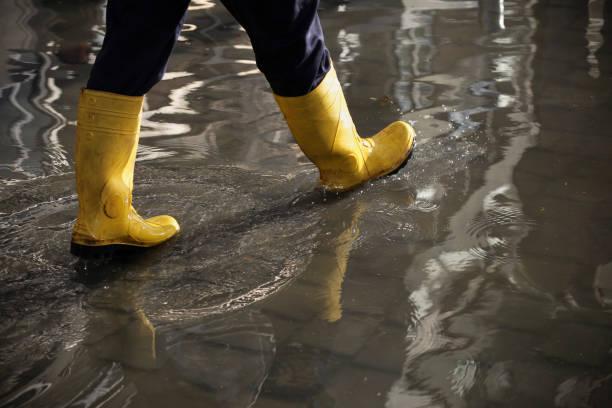It is a very obvious and logical thing to wonder whether gumboots can be used in snow. And after all, why not? Snow is just frozen water and gumboots are pretty much waterproof. Therefore it makes sense that you can wear them in snow as well, right?
Well, the answer to this is now clearly not a yes but do not be disheartened as it neither is a big no. Pretty confusing, eh?
To understand whether it is possible for you to wear gumboots in snow, you have to understand firstly, the type of boots they are, what’s special about them, and how they act and react to the surfaces they are worn on. So, without further ado, let’s put on our gumboots and get ready to read their tale.

The Story of Gumboots
Gumboots is basically long rubber boots that you wear to avoid getting your feet wet and dirty. Primarily used in the rainy season, these boots were interestingly invented by the first Duke of Wellington, Sir Arthur, in the first half of the 19th century.
The reason why he had his shoemaker invent this shoe was to make his previous calfskin boots more versatile and suited for everyday use.
Surprisingly, the modifications made to the Hessians(soft calfskin boots) by the shoemaker allowed them to be well-suited for both battle and everyday use without losing any of their grace.
Such versatility is uncommon even now and it undoubtedly added a charm to these leather boots that quickly made them popular.
Yes, you read that right. Interestingly enough, your favorite weatherproof boots were made of leather until 1852, when natural rubber became mouldable with Charles Goodyear’s discovery of the sulfur vulcanization process.
That’s also where the name Gumboots comes from, though these are also called rainboots, muck boots, gummies, and so on.
These days, gumboots are often composed of rubber or halogenated polymer polyvinyl chloride (PVC), which is waterproof.
Too technical? Well basically, this means that gummies are commonly the best choice to wear when walking on muddy or wet surfaces as they shield their user from strong downpours and puddles.
Why Gumboots?
Now since we already know a little bit about gumboots, let’s dive deeper into why and when people wear them? With that, you can check whether they will be the best choice for you or not.
Here are just some of their conveniences:
1.) Protection: Gumboots are a very good option to save yourself from anything that might ruin your regular formal or sports shoes. Whether it be dirt and mud or twigs and leaves, gumboots ensure that your feet remain warm and protected in them.
2.) Versatility: Gumboots can be worn by people who explore forests and damp terrains, people who work in the rice fields, people who live in rain-infected areas, or even people who just want to wear something for their daily activities such as going out shopping or cleaning their backyard.
The beauty of gumboots is that their utility rarely runs out.
3.) Waterproof: The best thing about gum boots is that they are waterproof, which should already be quite obvious(duh!).

The other thing, though, is that some gumboots also offer insulation which helps you keep away from being electrocuted(yikes, who would want to experience that?).
4.) Style: Now this is one aspect of Gumboots that people often seem to ignore: Gumboots offer you instant style!
Depending on the purpose and use, whether you want something lightweight and easy to wash or whether you want something durable and water-resistant, gumboots are available in a variety of styles and colors that you can mix and match to suit your unique style.
Gumboots and Snow
After the rainy season is gone and the winters are yet to come, a very common question that comes across everyone’s mind is, “Will the gumboots that I used during the rainy season work in the snow as well, or will I especially need to buy snow boots for the snow?”
Well, the answer to this question is a bit tricky, simply because it depends on the amount of snow your place experiences.
So, if the place you live in experiences snow frequently and more often than not covers the surface with more than 3 inches in depth, gumboots might not be the best choice for you. There are three reasons why:
1.) First: Although gumboots have a better grip than your usual formal and sports shoes, they still fall short when compared to shoes specially made for places with snowy weather, the snow shoes.
2.) Second: Although gumboots are usually your best bet to avoid your feet from becoming wet, snow can prove to be tricky for them.
This is because it sticks to your clothes and boots and as you walk, it can easily slide within them, making your feet catch a chill instantly.
3.) Third: Gumboots may crack in the snow as they aren’t made for sub-zero temperatures. In very harsh cold conditions, gumboots won’t work for long.
In just under an hour or so, you’ll feel cold and might even be freezing soon. And that’s even if you are wearing it with thick woolen socks.
QuickTime Alternative
However, if the place you live in experiences little snow and you don’t want to make an additional investment before the winters, gumboots might prove to be a great alternative for you!
Only if you take a close look into the features, uses, and styles will you notice a stark difference between a snow boot and a gumboot. A gumboot, therefore, can be used as a replacement for a snow boot to a certain extent.
This is though, only applicable in a few cases. For instance, if you stay in a place where it seldom snows and you do not necessarily have to walk on snow for a long time or if you are simply visiting a place where it snows and you won’t be exposed to snow for a long duration of time, then you can surely go ahead with your gumboots.
Are Snow Boots worth buying?
So, what about the snow boots, are they a better alternative?
It might seem redundant to buy a snow boot if you have your gumboots but the real thing that you have to look at are the features that the product is offering you.
If you believe that one certain kind of boot is good for you, then the first thing you have to do is to compare both the products with each other before opting for either of them.
There are some major differences between gum boots and snow boots that you need to keep in mind before you opt for either of them, depending on the terrain that you plan to walk on:
| Gum Boots | Snow Boots |
| Gumboots are made of PVC or rubber. | Thick nylon, wool, leather, and occasionally rubber can be used to make snow boots. |
| Gumboots are more flexible than snow boots. | Snow boots are heavier than rain boots. |
| Gumboots provide better protection from bushes and insects. | Snowboots are not the best choice in forest terrain. |
| If the temperature is higher than 5°C, gum boots may be worn. | Snow boots are much more suitable for cold weather |
| Gumboots have a poorer grip on snowy surfaces. | Snow boots are made especially for snowy surfaces and, therefore, can help you avoid slipping. |
Gumboots Versus Snowboots
Let’s get one thing clear first, gumboots will not go through heavy snow. And that is exactly why snow boots are made, so that snow does not fall into your boot that easily.
This helps you keep your feet from getting wet and cold. Snow boots even have a grip on the bottom which helps you to get good traction and walk on the snow even better.
But while the snow boots may sound too good for the snowy weather, they also come with their own perks and fallbacks.
Snow boots are very heavy when compared with gumboots and even ankle-length snow boots may tire you down very fast. Therefore, for city commuting, you have to carry along an unwanted load on your feet.
Owing to the material with which they are made, snow boots are much stiffer than the gumboots and take comparatively much more time to make your feet warm and comfortable.
See also: Snow Boots Vs Ski Boots
Conclusion
Ultimately when we go on to question which boot remains the best for snow and if gumboots are a safe choice to walk on the snow, then after considering all the conditions mentioned above, you have to look at it rationally and consider the level of snow you’ll be going through.
Because if you are going to be in a place where the level of snow is higher than 3 inches, then the main feature of the boot you’ll need is traction, that is, the grip that will help you walk through the snow.
And in this case, snow boots clearly outperform gumboots and are the better alternative to give you the grip in heavy snowfall and will keep you from tripping and slipping.
On the other hand, if you’re going to be in a place where it rarely snows, you can hold on to your gumboots and wear spikes on gumboots whenever you need a better grip!







